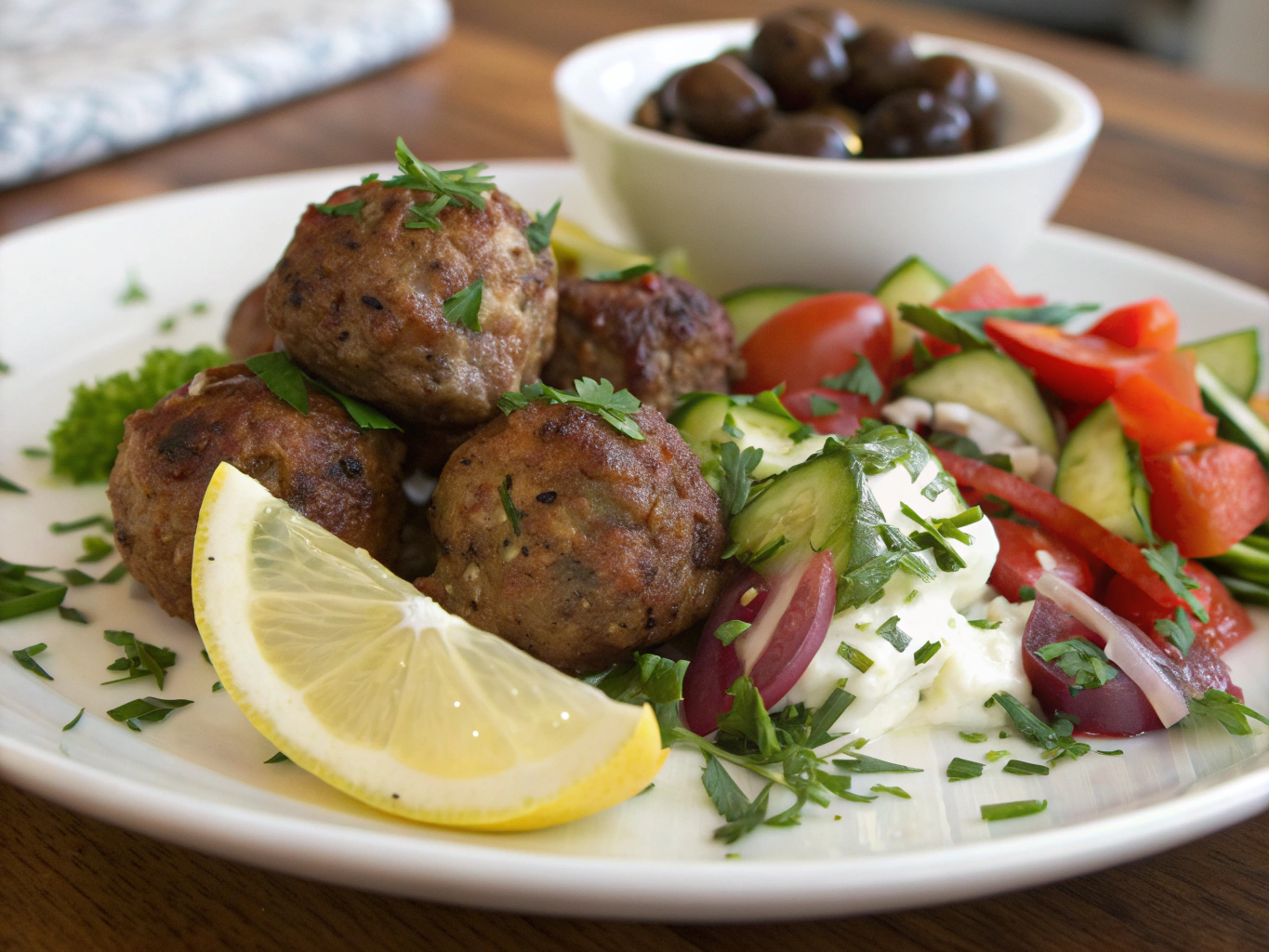
If there’s one dish that reveals how much a plate of food can hold memory, scent, and soul—it’s Greek meatballs. This article dives into the warmth of Greek soutzoukakia, combining spice, tradition, and comfort. You’ll discover why this dish has stood the test of time, how to cook it from scratch, and even how to make it flex to your busy schedule. Along the way, I’ll share how Greek meatballs remind me of Sunday potlucks and my grandmother’s hands, busy folding flavors into magic. Let’s dig into everything from ingredients to FAQs—your adventure in Mediterranean comfort begins now.
Greek Meatballs and MacMar’s Kitchen Memories
My First Taste of Greek Meatballs
My journey with Greek meatballs started not in Athens, but under the humid skies of Charleston in my grandma’s kitchen. She never called them soutzoukakia, but the flavor told a different story. Bold cumin, savory garlic, and the tender embrace of ground beef floated through her little house every Sunday. At potlucks, I’d bring these little flavor bombs packed in Pyrex, only to return with an empty dish and a list of recipe requests.
Cooking by instinct—that’s what she taught me. And when I finally tasted authentic soutzoukakia in a tucked-away diner near the Charleston docks, it felt like a homecoming. It confirmed what I already knew: comfort food crosses oceans. These days, Greek meatballs are a FlavivoRecipes favorite, tucked in between rustic chickpea patties and one-pot lentil stews.
There’s something deeply soulful about these meatballs—moist, warm with spice, and simmered in thick tomato sauce. Even as I tweak the recipe for modern kitchens, the essence always remains.
What Makes Soutzoukakia So Iconic?
Greek meatballs—known locally as “soutzoukakia Smyrneika”—are meatballs seasoned mainly with cumin and garlic, typically cooked in a rich tomato sauce. Simple, right? But what transforms them into mouthwateringly memorable meals is tradition. These meatballs originated in Smyrna (modern-day Izmir, Turkey) and were brought to Greece by refugees in the early 20th century. They represent resilience and the shared love of flavor across regions.
What separates soutzoukakia from your standard Italian meatballs is the use of spices like cumin and sometimes cinnamon. They’re usually oblong-shaped, paired with rice or thick-cut bread, and slowly simmered. The tomato sauce isn’t just a dip—it’s part of the flavor dance that soaks every bite.
These meatballs are your family’s new favorite Sunday meal—easy enough for weeknights, rich enough for company, especially when served with crusty bread and a chilled carafe of white wine.
How to Make Greek Meatballs: Smoky, Juicy, and Comforting
Ingredients List
The beauty of Greek meatballs is that they’re incredibly forgiving. You don’t need a trip to a gourmet grocer to pull this off. Here’s what you’ll need:
- 1 lb ground beef (or a mix of beef for richer flavor)
- 2 cloves garlic, finely minced
- 1 small onion, grated (this adds moisture)
- 1 egg
- 1 tsp ground cumin
- ½ tsp ground cinnamon (optional but traditional)
- ¼ cup fresh parsley, chopped
- Salt and freshly ground pepper to taste
- ½ cup breadcrumbs soaked in a splash of milk
- 2 tbsp olive oil (for frying)
For the sauce:
- 2 tbsp olive oil
- 2 cloves garlic, minced
- 1 medium onion, finely chopped
- 1 can (14 oz) crushed tomatoes
- 1 tsp sugar
- Salt and pepper
- ½ tsp cinnamon (optional)
- 1 bay leaf
🆁 Tip: Substitute turkey for beef if you’d like a leaner meatball. Gluten-free breadcrumbs work perfectly for GF adaptation.
Timing: Fast and Flavorful
Here’s how your time breaks down:
| Task | Time Required |
|---|---|
| Prep Time | 15 minutes |
| Cooking Time | 30 minutes |
| Total Time | 45 minutes |
That’s 25% shorter than many Mediterranean meatball recipes. Ideal for busy weeknights!
Step-by-Step Instructions
- In a large bowl, combine the ground beef with garlic, onion, parsley, spices, soaked breadcrumbs, egg, salt, and pepper. Mix until just combined—don’t overwork it!
- Shape the mixture into elongated meatballs, about the size and shape of your thumb.
- Heat olive oil in a skillet over medium heat and brown your meatballs on all sides. Set them aside.
- In the same skillet, sauté the onion in olive oil until softened. Add garlic, cook another minute.
- Stir in crushed tomatoes, sugar, spices, and bay leaf. Slide meatballs into the sauce, lower heat, and simmer partially covered for 25 minutes.
- Remove bay leaf before serving, and plate with rice, potatoes, or crusty bread.
By the end, your kitchen should smell like a Mediterranean taverna. More than a meal—it’s a mini trip to Greece.
Greek Meatball Variations and Serving Strategies
Creative Twists for Your Table
Greek meatballs are wonderfully adaptable. While the traditional version stars beef, you can switch things up easily. Ground lamb adds earthiness, while mushrooms finely chopped into the mix can bring moisture and offer a semi-vegetarian spin.
Want to go fully plant-based? Swap in lentils and eggplant to echo similar textures. You can look into flavors used in spicy roasted eggplant stew for seasoning clues.
Sauce variants also offer room to play. A white wine lemon butter sauce creates a lighter finish for spring dining. Or replace tomato with a red wine reduction and wild herbs à la moussaka.
No matter the creative detour, cumin and garlic must stay. They’re the soul ingredients that define Greek meatballs—the familiar heartbeat in every twist.
What to Serve With Soutzoukakia
You’ve got those juicy meatballs in tomato sauce—now what? Pairing is important to balance texture and flavor.
- Rice pilaf: Mild, fluffy, and easy to spoon into every bite.
- Mashed potatoes: A southern twist my Charleston roots can’t resist.
- Greek orzo: Tossed with olive oil and lemon zest.
- Steamed greens: Broccoli or chard dressed with salt and vinegar.
- Crusty sourdough: For dunking that glorious sauce.
To see how this balances in a whole meal, I often look at Mediterranean diet tips from MyPlate.gov, reminding readers to consider protein variety and preparation style.
Greek soutzoukakia work great as part of a mezze spread too, sitting next to hummus, warm pita, and spicy roasted olives. They’re flexible, friendly, and flattering on any plate.
Make-Ahead Tips, Storage, and Reheating
Meal Prep and Make-Ahead Options
Greek meatballs are a prep-ahead dream. You can form the meatballs a day in advance—just keep them chilled and covered. Or cook them fully and refrigerate for meals throughout the week.
The flavor improves after a night in the fridge as the spices settle and the tomato sauce deepens. No kidding—day-two Greek meatballs might be even better than fresh ones.
Freeze cooked meatballs and sauce together in portions. They’ll store well for up to 3 months. Reheat slowly in a skillet to keep them juicy. You can microwave them, but a stovetop reheat gives better flavor retention.
Storing Leftovers Without Losing Flavor
All leftovers keep in an airtight container in the fridge for 3–4 days max. Add a splash of water to the sauce as you reheat to loosen it back into that silky texture.
One tip my followers love: Turn leftovers into a wrap. A warm pita, some tahini or yogurt sauce, and those meatballs wrapped up with shredded greens—it becomes an easy lunch that punches well above its weight class.
Greek meatballs are the kind of food meant for sharing. Whether it’s a slow dinner with friends or packed up for a solo work lunch, these humble heroes deliver every time.
FAQs about Greek Meatballs
What is the name of the Greek meatballs dish?
The traditional Greek dish is called “Soutzoukakia Smyrneika.” It’s an oblong-shaped meatball simmered in tomato sauce, originating from Smyrna, now Izmir, Turkey.
What are traditional Greek meatballs with cumin?
Traditional soutzoukakia are made with ground beef or lamb, seasoned with garlic, parsley, and a generous helping of cumin—one of the core spices that gives Greek meatballs their signature aroma.
What is traditional Greek meat?
Traditional Greek meat includes lambvand beef, often seasoned with herbs like oregano, thyme, and bay leaves.
What is Greek soutzoukakia?
Soutzoukakia are spiced meatballs of Greek and Turkish origin, usually served in a rich tomato sauce, often accompanied by rice, potatoes, or bread. The defining ingredients are garlic and cumin, and sometimes cinnamon.
Conclusion
Greek meatballs, or soutzoukakia, aren’t just another comfort food—they’re a celebration of memory, bold flavor, and easy sophistication. Whether you follow the traditional route or play with fusion-style twists, this dish encourages playfulness and warmth in your kitchen. My grandmother’s guidance, a little trial and smoke alarm error, and years of tweaking have made this recipe a core part of my identity—something I now get to share with you.
Ready to keep cooking? Explore other Mediterranean staples on plant-poweredrecipe.com like the vegan shakshuka or vibrant falafel-stuffed peppers. And as always, keep that curiosity simmering—you never know when your next favorite meal will find you.
